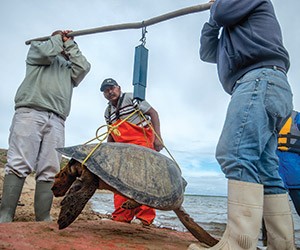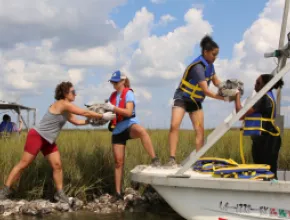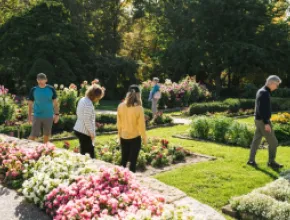From wildcat sanctuaries to farm animal rescues, outlets abound for groups to help their four-legged, reptilian, winged and underwater brethren. Across the world there is a variety of options for CSR outings that incorporate animal welfare.
Meet Henry, a chimpanzee who was rescued from a garage where he lived in isolation in a small cage for 15 years. He was rescued by Chimp Haven, located in Caddo Parish, La., near Shreveport, and made a full recovery, becoming the leader in his social group at the sanctuary.
Henry is just one of more than 230 chimps at Chimp Haven, a private, nonprofit federal sanctuary. All but 14 of the chimps are owned by the federal government, with the majority retired from the biomedical research industry.
Set on 200 acres of forest, Chimp Haven’s facility includes an interconnected network of bedrooms, outdoor courtyards and play yards, and large, forested habitats of up to five acres. Special “Discovery Days” are open to the public only seven days of the year. Groups are welcome to visit for a day and volunteer, with the added bonus of a tour of the sanctuary, according to Cathy Willis Spraetz, president and CEO.
Volunteer work for groups can include planting fruit trees for the chimps, tending to the outdoor garden and building mind-enriching puzzles. Visitors can observe the residents in their enclosures, though there are no direct hands-on opportunities.
“We have a no-touch policy. Even our animal care staff doesn’t touch, but there are lots of opportunities to watch them,” Willis Spraetz says.
The sanctuary can accommodate up to 25 guests at a time.
There are plenty of hands-on opportunities at Colorado Horse Rescue in Longmont, Colo., near Boulder. The nonprofit is dedicated to providing emergency relief, shelter, care, rehabilitation and adoption services for abused, abandoned and unwanted horses. About 80 percent of the 50 to 55 horses at the ranch are surrendered, many for financial reasons.
PageBreak
Groups of up to 15 can come for a day and build snow fencing, construct shelters, work on barn maintenance, wash blankets, move hay and partake in other facility projects.
According to Shawna English, adoption and equine training coordinator, the rescue will also soon be implementing a teambuilding program focused on leadership.
“Horses mirror your body language,” English says. “To get them to walk forward, you have to walk forward with intention, which relates back to the workplace.”
At Gentle Barn, in Santa Clarita, Calif., a farm animal sanctuary with more than 170 animals rescued from abuse and neglect, groups can take short tours, meet the animals and spend the day upgrading the facility.
“What we’ve done in the past is have groups come out and paint barns and fences,” says Jay Weiner, co-founder. “They’ve also helped with construction around the garden so birds won’t eat the vegetables.”
The property houses everything from rescued chickens to horses. Since its inception in 1999, Gentle Barn has been home to hundreds of animals and host to over 400,000 people.
Pasado Safe Haven, located on 85 wooded acres near Seattle, is also home to hundreds of animals, including dogs, cats and farm animals, most rescued from abuse or neglect.
Groups are invited to participate in what the rescue calls work parties, engaging in a variety of tasks, like painting buildings and barns, digging manmade ponds for resident ducks, and clearing paths for dog walking.
Watermelon Mountain Ranch, in Rio Rancho, N.M., is the state’s largest no-kill animal shelter, with a 10-acre facility that houses cats, dogs and some farm animals.
Groups of up to 40 can help at adoption events, as well as on the ranch itself, doing everything from landscaping and construction to direct animal caretaking.
“We have worked with several different corporate and convention groups in the past for teambuilding and service outreach” says Sara Garrigan, director of marketing and development.
PageBreak
At the Dolphin Research Center (DRC) in Grassy Key, Fla., established in 1984, most of the 24 dolphins were born at the center or came from other facilities. Others have been taken in as rescued youngsters after they were deemed non-releasable by the federal government.
Groups can volunteer working on seasonal projects, according to Becky Rhodes, director of volunteer resources for DRC.
“They can get in the water, but on the other side of the fence than the dolphins, scrubbing sea grass off the fences,” Rhodes says. “We also have a lot of landscaping projects, such as removing all exotic and invasive trees from the landscape.”
The center is also a member of the Marine Mammal Stranding Network and assists in rescuing marine mammals in distress, including whales and manatees. Research projects include behavioral studies for wild dolphin populations in the Florida Keys.
In Mexico, turtle release programs are popular with groups. In the Baja area, RED Sustainable Travel operates corporate trips for up to 16, promoting teambuilding and helping in local conservation. The company’s flagship multiday trip, Magdalena Bay Sea Turtle Conservation Adventure, lets attendees partner with local fishermen for a black sea turtle conservation program. Groups accompany the local conservation team to set nets, capture, measure, tag and release sea turtles.
On the Riviera Maya, U.S.-based CSR provider Travelfuture offers its Turtle Release Activity program in September and October, which can be customized for groups and benefits a local nonprofit. Visitors head to the nesting grounds at Xel Ha to witness the release of the baby turtles hatched that day. Options include a 90-minute introduction about the types of turtles that nest on the beach and information about conservation efforts.
Farther afield, groups can volunteer at the Cheetah Experience, a small nonprofit situated in Bloemfontein, in central South Africa, where the focus is to breed cheetahs in captivity with the hope to one day release them back into a “protected” wild. Volunteer activities for groups of up to 50 include the preparing of raw meat to feed the big cats and cleaning their enclosures, as well as babysitting and walking the animals.
In Australia, groups can get involved in koala conservation at the government-owned You Yangs Regional Park outside Melbourne. Tour operator Echidna Walkabout runs eco-tours, koala research and koala habitat restoration projects in the park.
Volunteer options include removal of the invasive boneseed weed from the koala habitat and helping track the wild koalas.
Groups interested in the Echidna Walkabout Koala Conservation Project can contact U.S.-based custom tour operator Swain Destinations.
Marlene Goldman is a world traveler, animal lover and frequent contributor to Meetings Focus.







